One of there reasons to go to an old car show isn’t so much because the cars are ancient but because they are weird – relative to the same, as they are today.
Weird under the hood, especially. Which is sometimes under the trunk.
One such oddball is the Chevrolet Corvair, which GM built as a kind of better VW Beetle – or poor man’s Porsche 911, depending on your point of view.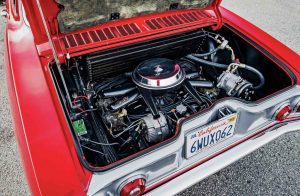
It was the late 1950s and in those days, cars were hashed out between the customer and the company, which designed the car in such a way as it hoped would appeal to him. There was no red-white-and-blue middleman interposing his notion of what ought to be designed and what ought to be bought. This allowed almost cartoonish freedom of expression, both form and function. It accounted for the almost Cretacious-looking mechanical velociraptors of the era, such as the grinning and finned Cadillacs favored by Elvis – as well as barely cars at all like the VW Beetle.
It defined minimalism in transportation. It didn’t even have an oil filter – just a reusable screen. Early models had a fuel dipstick. There was just enough horsepower to achieve 60 or so MPH if the road was flat and the headwind light. It wasn’t much, but it beat walking and millions were sold to empty-pocketed post-war youth and to millions of others who simply liked the idea of keeping what they had in their pockets.
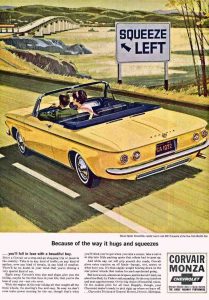
GM thought the idea was sound, which it obviously was as the cars sold so well they were eating into GM’s small-car profits.
Why not build a better Beetle?
This was the genesis of what became the Chevrolet Corvair, which made its public debut in 1959 for the 1960 model year.
Unlike the Beetle, which came just one way – a two-door hardtop coupe with very cramped rear seats – the Corvair was offered with two or four doors and with – or without – a roof. It also offered multiple configurations of its air-cooled, trunk-mounted six-cylinder engine.
The Beetle’s four cylinder engine came just one way – the underpowered way. You could hot-dog thing with aftermarket parts – and this was a popular diversion among the youth of the ’60s – but the as-it-came Beetle offered your choice of slow or slow – in your pick of colors, at least.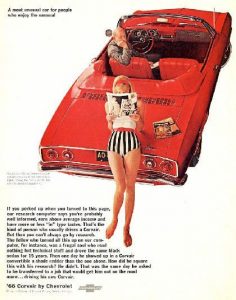
This isn’t criticism. It was in keeping with the Beetle’s prime directive. Simplicity uber alles. It wasn’t literally the people’s car – volks wagen – for nothing. Specifically, the German people in the aftermath of the Great War, which left millions of them on foot and in need of a way to get around otherwise that was within their means. Germany in the early ’30s was in some ways like America had been 30 years earlier. The volk needed a wagen that was basic and cheap – with everything else optional. Or not even available.
The Beetle was Germany’s Model T.
But in America, by 1960, something more was wanted – or at least, there seemed to be a crying need for it.
Hence the Corvair’s standard six-cylinder engine. Like the Beetle’s four, it was horizontally opposed as well as air-cooled. But very much unlike it, the Corvair’s engine came standard with two carburetors rather than just the one – and you could opt for four of them. There were also hotter camshafts – and even a turbocharger, an exotic thing back in the ’60s.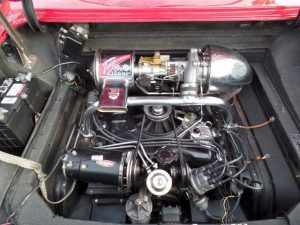
Hence the inevitable – and favorable – comparisons of the Corvair with Porsches, which were similarly laid out but a lot more expensive. The Corvair wasn’t much more expensive than a Beetle – which was rarely compared favorably with Porsches. In fact, when it went the other way – Porsches with VW-related engines – the comparison was generally held to be extremely unfavorable.
To the Porsche.
The ‘Vair was – like the Porsche – a technical tour d’ force for its era. Its aluminum engine used intricate casting technology light years ahead of the crude-by-comparison rough cast-iron pourings then typical. Its rear-mounted transaxle was also exotic for the time.
As, of course, was is handling – which proved to be its undoing.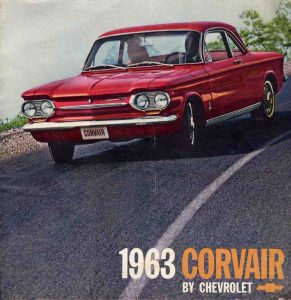
Not because it handled poorly. In fact, it handled excellently in comparison with the bias-ply’d road oafs of the era. The problem was marketing mismatch.
Few regarded the people’s car as a hot rod and thus it wasn’t driven like one. More to the point, it was hard to drive the people’s car like a sports car, even if you tried to. There’s only so much trouble you can get into in a car with 36 horsepower and a top speed, all out, of maybe 80 MPH.
But the Corvair offered 110 horsepower – in the Monza – and 150 in the turbo’d Spyder. This caused some people to drive it like a Porsche. Many of these would have been kept in check – as regards the Porsche – by the Porsche’s inaccessibility due to its unaffordability. The people who could afford one generally knew how to drive one.
But the average American had never driven a rear-engined sporting car with an independent suspension (then an exotic thing) at high speed – and understood nothing about the criticality of differential tire pressures to handling stability in a car with a heavy rear and a light front.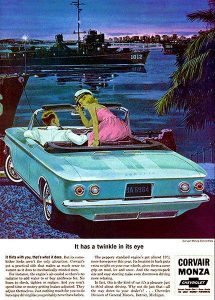
They suicidally filled all four tires to the same pressure – an error compounded by their not knowing to stay on the gas in a high-speed curve. The result was sometimes fatal tuck and roll – and the exploitation of a few high-profile such incidents (e.g., the death of the comedian Ernie Kovacs) by an emergent young ambulance chaser by the name of Ralph Nader.
The Corvair – which was only “unsafe” at speed if there was an idiot behind the wheel – was effectively tarred-and-feathered by Nader, who never pursued the essentially similar Beetle or Porsche for the same supposed crimes. Though hugely successful at first, the juggernaut of bad press generated by Nader did to the Corvair what “cheating” on government emissions certification tests has done to modern diesel-powered VWs.
Both are no more.
Which is a shame – because both gave customers something different for a change. In the land of the same-same, that’s now a no-no.
. . .
Got a question about cars, Libertarian politics – or anything else? Click on the “ask Eric” link and send ’em in!
If you like what you’ve found here please consider supporting EPautos.
We depend on you to keep the wheels turning!
Our donate button is here.
If you prefer not to use PayPal, our mailing address is:
EPautos
721 Hummingbird Lane SE
Copper Hill, VA 24079
PS: Get an EPautos magnet or sticker or coaster in return for a $20 or more one-time donation or a $10 or more monthly recurring donation. (Please be sure to tell us you want a magnet or sticker or coaster – and also, provide an address, so we know where to mail the thing!)
If you’d like an ear tag – custom made! – just ask and it will be delivered.
My latest eBook is also available for your favorite price – free! Click here. If that fails, email me at EPeters952@yahoo.com and I will send you a copy directly!


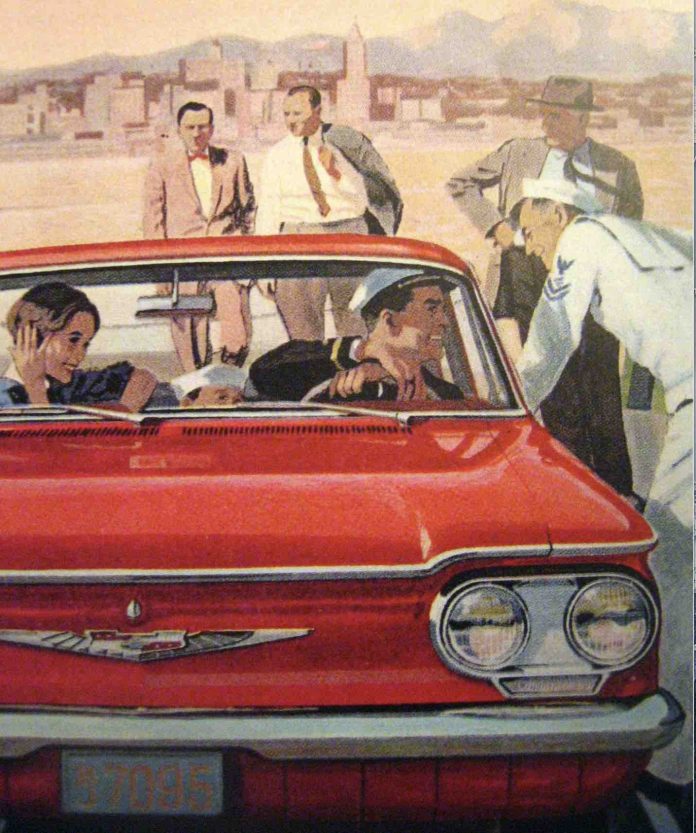








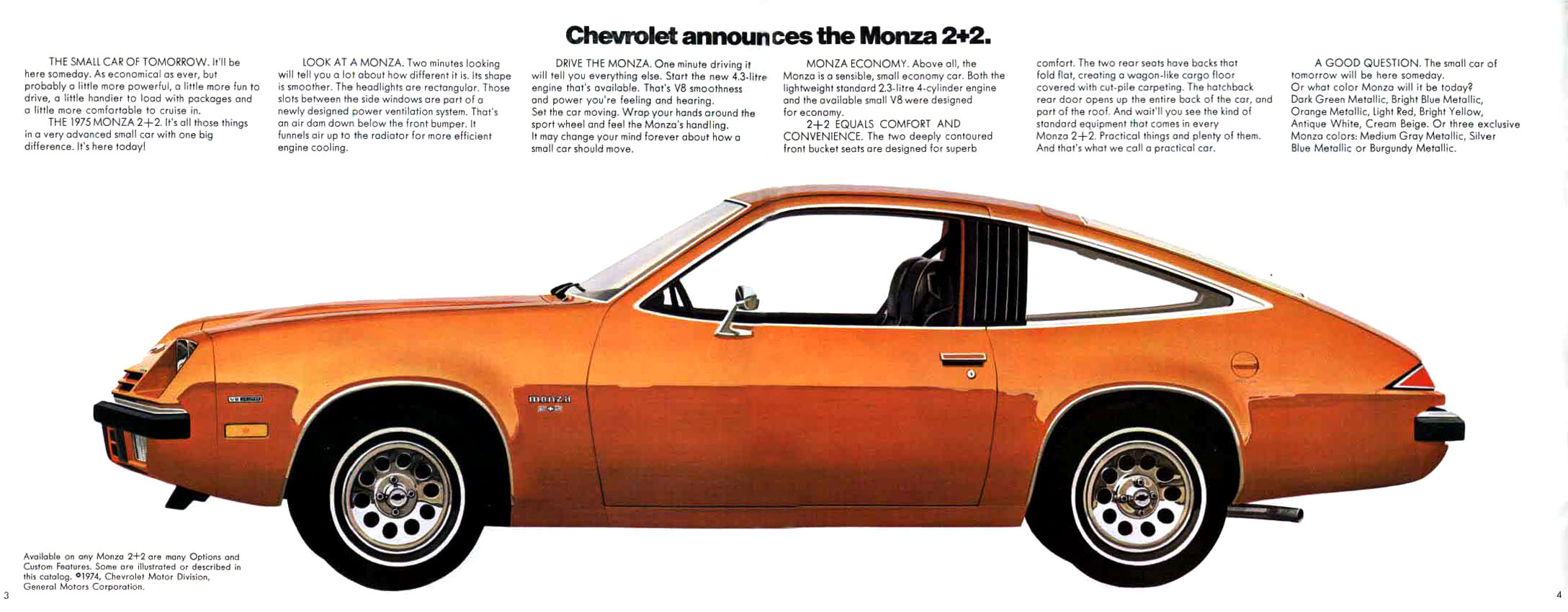
Thanks Eric,
You brought back memories of the white ’63 Monza Spyder convertible (red interior) my dad had.
I was a wee lad but have vivid memories of that cool car. Unfortunately, in less than 2 years he had a number of problems with it, the last straw being a hot summer, middle of nowhere breakdown, tow etc. (an Alpha Romero can get away with that, not a Chevy Corvair…)
In ’65 he replaced it with a 356C (last year of the bathtub Porsches) which I eventually ended up with. (But being a dumbass, I sold it after a few years to buy something with more get up and go…)
I recall that the heater in the Corvair was barely adequate for a mid western winter. There you go – something not great about the Corvair.
Hi Anon,
Actually, air-cooled engines heat better – or at least, faster. Assuming the tin work/fan, etc. are in good order. Having owned several old VWs as well as a ’64 Corvair, I can personally attest to this. The heat comes on almost immediately – because the air-cooled aluminum engine warms up almost immediately vs. the water-cooled cast iron engine (in the cars of that era). The Corvair’s body was also tighter and better insulated than the Beetle’s.
The cars – both of them – have a bad rep in re the heaters because they work terribly when the tinwork has been screwed with or the system (including the thermostats on the air doors in the ‘Vair) hasn’t been maintained correctly. But that’s the same as faulting a 289 Hi-Po Mustang for not running well because the points in the distributor are worn.
People forget that cars of that time almost all needed much more frequent maintenance; not major work – but minor adjustments – to be kept in proper running order. Many people didn’t do these adjustments – or did them incorrectly. And the Corvair – like the Beetle – was an oddball car with systems unfamiliar to most Americans, which made the problem worse.
But if adjusted correctly – this includes tire pressure – the Corvair was a wonderful little car, both then and now.
Ralph Nader did not kill the Corvair…..the market did. Or you could call it suicide. Yes, it did handle great….and safely, by the standards of the day. Was good looking too, especially the interior of the Turbo Monza Spyder.
But even by the standards of the day it was horribly unreliable. And pathetically, disgracefully slow. Eric is one of the few who actually owned one who still speaks fondly of it. Virtually nobody who bought one Corvair would ever buy another.
Unlike GTOs, 409s, XKEs, Mustangs, T-Birds, Little Deuce Coupes……..and even ’40 Ford Wagons and the Little Nash Rambler Whose Horn Went Beep Beep Beep …… pop culture never generated a hit song celebrating the Corvair. That’s a conspicuous absence for a car that was supposedly All That Great.
Sorry, Mike. As a one-time owner of a ’67 Corvair Monza (the 4-speed, dual-carb, 110hp variant), I have to (respectfully) take issue with some of your statements.
Most cars of that period were ONLY as reliable as the care and maintanance they received. I bough mine in ’77 in a private sale. It ran poorly during my test drive, but I knew how to fix that. My father worked on cars all his life (we didn’t have much money), and taught me to do the same. I bought 2 carb rebuild kits from the local GM dealer on the way home. Cleaned/rebuilt both carbs the next day, popped them back on, and re-tuned her (I had to sync the carbs without vacuum guages) until that motor ran like new. It wasn’t a race car, but when I stomped the gas, she moved. Ran her for years (even raced a few folks now and then). Replaced the fan belt ONCE. I always carried a spare. Belts weren’t as long-lasting back then.
I’ve owned a lot of different cars over the years. Can’t say the Corvair was my favorite. But it was unique, and I remember it fondly.
EVERYONE I’ve ever encountered who has ever owned a Corvair- be it back in the day when it was current, or as a used beater later on…or as a vintage tow….have always had only great things to say about them.
Same here, Nunz!
I owned my ’64 for about ten years in the ’90s/early 2000s. It was a much better car than the several Beetles I’ve also owned, much as I revere them, too. But unlike the Beetles, the ‘Vair had ample power for comfortable driving with today’s traffic, including on the highway – where it had no trouble at all maintaining 75. Beetles did. The reason, of course, is that the Beetle was designed for a top speed – in Germany, 1930s-era – of around 70. The ‘Vair was designed for American roads and the Interstates, which were designed for average road speeds of 70-75. I can attest the ‘Vair could do 100-plus.
The ‘Vair was also much more comfortable and roomy – and its heating system vastly superior.
I wonder whether Mike has ever driven one.
Heh, yeah, Eric- I love the idea of the Beetle….but I don’t think I could live with one (But wouldn’t mind playing around with one for a bit)- But the Corvair…. I’d LOVE to have one as a driver! Saw a decent-looking one a few years back, locally, for around $5K- wish I would’ve checked it out!
Mike,
Have you ever owned or driven a Corvair? Or are you basing your comments on what you’ve read about them? I’ve owned one – and driven several. If you haven’t, you might be surprised how modern they feel relative to most cars of the ’60s. They were very nimble, easy-to-drive cars and as far as reliability, they were no worse than typical of the era and in some respects better in that they were much simpler and had fewer things to go wrong.
My fiancé’s VW tried to kill me when I borrowed it to make a quick parts run down the canyon to town. Somehow I intuitively jerked it out of it and continued on my way a little less quickly. A few weeks later she drove it off a cliff, but it was years later that I connected the two incidents with the swing axle rear end and the “Corvair” problem.
wait what? more words for comment approval
The VW had the same problem as the early Corvair, if you could get it going fast enough to discover it. Going downhill a little bit helps I reckon.
But you never heard Nader say a bad word about the Bug.
Two books, Unsafe at Any Speed and Silent Spring, went on to define the modern worry culture. Both books were based on junk science and victim-as-identity for their justification. Politicians, seeing a way to differentiate themselves from the status-quo played up these unnecessary fears and built the modern nanny culture.
If only the “leadership” of the Libertarian Party could learn that lesson.
The Libertarian Party has become a red herring, just like The Flat Earth Society or PETA- an organization which exists just to waste the time of outliers; spread disinfo and create a slanderous image of the true believers of their namesake causes, and to just draw away the less discerning from the real cause.
PETA’s reason of existence is to abolish animal ownership. They’ve done such an excellent job of conditioning the public with anthropomorphic propaganda that the public sees nothing wrong with the asinine idea of animals having rights.
the so-called libertarian party has a real problem. they dont support libertarians but fake idiots like the 2016 guy. A real third party is desperately needed and most Americans support libertarian ideals. Its not that difficult,
Most Americans are communists- they just don’t realize it, or won’t admit it.
Be nice Nunzio… ^^ I’d not say just commies, as much as collectivists of one type or another. But that’s due to generations of indoctrination and mass media propaganda.
As for the Libertarian Party, it isn’t libertarian. That’s why I use the upper case for the Party and its hangers on, and the lower for those who know and practice the principles.
Preaching to the choir, Beeg. I hate to even refer to myself as a Libertarian, after they ran that Gary Johnson fool in ’12 and ’16 -as after that, a lot of people thought that that was what a Libertarian is (He’s a freaking Republican).
But Americans aren’t just collectivists…they are commies. The average American- be he red or blue (I guess a blue one is a red one that has been deprived of air) believes in virtually all 10 points of the Communist Manifesto: “Free compulsory edumacation; Progressive graduated income tax; One centralized state bank which controls credit….”
Some may say they object to a few of ’em, like the abolition of private property or the liability of all to labor….but in reality, just as with “gun control” they advocate and practice the very things which are in the very process of establishing that which they profess to oppose- such as “planniong and zoning” and property taxes- which have essentially already relieved most Americans of any true private property in anything but name only.
I had high hopes for GJ until he demonstrated his complete ignorance of geography. After that, forget it.
Go climb another mountain, Gary…if you can find it.
The Libertarian Party is full of morons and leftists. I mean, what kind of libertarian political organization would have the loathsome Bill Weld on their ticket?
Maybe they’ll nominate Hillary this year?
The Libertarian Party is just as insane as any other organization that presumes using the very same system that created the vast majority of problems we face to solve those problems. “If only we could put the proper psychopaths in charge of holding a gun to our heads and forcing us to do, or not do this or that, we could achieve utopia.” The ONLY purpose it serves is as a legitimate target of ridicule with which to equate those of us who happen to be real libertarians. It consists mostly of those who are acquainted with the concept, but have yet to understand it.
Hi JWK,
Agreed. I prefer a Libertarian movement. Which is to say, the spreading of Libertarian ideas. Which, if they take hold, would make “parties” absurdities.
While those books contributed to the nanny state culture, the precursor I believe was Roosevelt’s New Deal and the its rekindling by Lyndon Johnson’s Great Society programs: The war on poverty, enforced affirmative action, quotas, lowering of educational standards to accomodate unqualified black students; and the massive guilt trip that white liberals of the time laid on themselves because being white, they believed they were as responsible for slavery and the post slavery Jim Crow laws as the white people who actually committed those crimes.
Right on, Art! This crap really started in earnest with the publication of Jacob Riis’s “How The Other Half Lives” in 1890! I guess Riis was the very model for SJWs, “social reformers” and nanny-state advocates. His garbage, in addition to the Triangle Shirt Waist fire in 1911, which provided the opportunity for union organizers to gain overwhelming support, as well as the catalyst for Uncle to start establishing OSHA-like mechanisms of control. Those things were only too happily received by the masses in the big populations centers- especially by the hordes of newly arrived foreigners in NY who were mostly uneducated unskilled laborers- you know the ploy “It’sa for our’a good! It’sa a good’a thing, Luigi!”- That, and the communism which was popular with the higher social class at the time….and then Prohibition and the New Deal, as you mentioned…with an ever-expanding government on every level, which culminated in WWII (“The Big One” -Archie Bunker) all at a time when compulsory “education” was just taking hold and had largely been shifted from local community control to more centralized control…. Uh…the 20th century was not a good time for liberty, despite liberty being more abundant and easier to obtain than it is now!
And of course, the establishment of the Federal Reserve system and income tax in 1913!
I’ve often said on here that the tyranny now extant is not just something that has just popped-up recently….but is rather something that has been bred into the citizenry and practiced and accepted as the norm for a century now….and thus is so much a part of what has come to be modern culture and thought, that even if the government folded tomorrow, the tyranny would not cease- because this model is all that most people know; it seems perfectly natural and reasonable to them; they believe in it…..and they will continue to live that way and to desire that model of governance, and therefore would just replicate what they had.
All of the above- all happily tolerated, voted for, and even fought for, for generations now. We’ve labored under that for 100 years….and now they’re just putting the finishing touches on it…closing up the loopholes, and using technology to take it to the ultimate level- but there is truly nothing new inder the sun…..
So true, Nunzio. It was just a matter of time.
And there are so many factors that stymie the spirit of freedom that we are born with: the fear of death and the desire for immortality and the modern belief that the state can save us, and how this makes us vulnerable to charlatans; ignorance of economics and the free market, how material prosperity we’ve enjoyed is created and maintained; our natural helplessness and our dependence as children on adults for our survival, and the extent to which our parents and the wider society do or don’t teach us to be independent as we morph into adults. And of course, our own inherent constitution, the strength of our curiosity, our willingness to be honest with ourselves despite the adversity of our family, our friends, and the whole world. And so much more.
The life of one person is so complex, I don’t understand it all. Which is why life is interesting to me. And you seem a kindred spirit.
Art; I’m glad you mentioned Silent Spring. How some nuctase woman got that garbage to pres still amazes me. DDT was not the cause of bird egg shells thinning or any of the other spastic ideas this hormonal closet lesbian advanced (with the help of a well organized Marxist machine).
The banning of the larvicide DDT made mosquito born Malaria the second (and in some cases most) vicious man killer in many parts of the world. Malaria is especially dangerous to children.
Apparently Rachel Carson’s pro mosquito agenda was, and still is more important and valuable than human life. Devaluing life is what Leftists do best.
To some degree, modern “worry culture” already existed. Those books might have given it more credence, acted as a catalyst of sorts, but consider that Nader had to come from somewhere. Exactly where he would have come from, I’m not sure, but he had to come from somewhere.
Down in Australia, the “Supercar Scare” of 1972 (https://en.wikipedia.org/wiki/Supercar_scare) proves that “worry culture” was already entrenched well enough, even in the place Britain once used as a dumping ground for the people it couldn’t handle back home, to destroy what could have been three amazing cars.
What the manufacturers should have done is offer the scolds rides in their cars… after outfitting them with hidden cameras, of course. They could either convince them to join the gearhead side of the fight, or get possible blackmail videos of grown men crying and blubbering like babies despite not being hurt.
I had a teacher in high school that used to race corvairs. He told us, way back then, that any rear engine car required that you knew how to drive. That the same thing would happen in a Bug if you had the tire pressure off and did something stupid. It had a 10 year run though, suit or not. The later ones weren’t even that bad looking.
BTW – It also came in a van.
Hi Techie,
Yup; I once owned a ’64 Monza four-speed. It was an excellent little car and – much as I revere the many VWs I have owned over the years – it was a superior car in almost every way.
Eric, I also had a ’64 Monza, but with the more pedestrian 3-speed stick. Wish I still had it. My preference if I were able to buy one today though would be for a 2nd-gen (1965+) model. Those things are sweet.
Remember that opening chevy TV commercial for Bonanza, where the airborne Coevair was featured? In 1968, I worked with a guy who was part of the film crew for that commercial. He told me that Chevy gave them a half-dozen identical Corvairs for that project and the ‘first five’ had their frames buckled on impact. Luckily for them, the sixth was the charm!
Hi RMH,
Yup! The same occurred during filming of Smokey & The Bandit. Word is that Pontiac gave the film’s producers six new Trans-Ams. Only one survived the filming…
“Cretacious-looking mechanical velociraptors” — yes, please, I would like one of those.
As well as the young lady in too-tight striped shorts, pasting her assets to the back of a provocative red ‘Vair, while some weird Freudian-looking guy in the driver’s seat, old enough to be her sugar daddy, coolly analyzes her body language.
Dude, it ain’t that complicated. Go for it …
One correction…
“e.g., the death of the comedian Lenny Bruce”
Lenny Bruce OD’d himself, I think you were thinking of that great TV pioneer Ernie Kovacs. He died in a Corvair wagon in LA. His words…”I was born to Hungarian immigrants, and I’ve been smoking cigars ever since!”. Gotta love a guy like that!
Thanks, Crusty – fixed!
This happens when I don’t get enough sleep…
Oh yeah, understand that Eric.
Keep it up, love this sort of thing, strange and wonderous cars very few nowadays have heard of, and their relationship to the modern regulative state.
In a way, the Chrysler Turbine Car was like the Corvair, in that you had to drive both almost counter-intuitively for the era.
You had to stay on the gas through corners in the Corvair and you had to firewall the gas pedal in the Turbine Car because of the way the engine delivered power.
Marketing dropped the ball in both cases – a car that could handle when driven correctly in a culture that wasn’t used to going around corners fast and a car that needed to be floored by people used to the giant off-idle torque spike of a big V8.
Thanks, Marketing. Bang-up jobs you did there.
Nice article Eric.
“…allowed almost cartoonish freedom of expression…”
This bit is why I loved early can-am racing.
AHHHhhhhhh! Thank you, Eric!
Great car….emblematic of a good era…and Ralph Nuder [sic- Archie Bunker] hates it. Win/win!